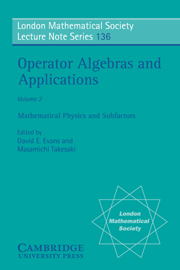Book contents
- Frontmatter
- Preface
- Contents
- UK-US Joint Seminar on Operator Algebras Lectures
- Some recent results for the planar Ising model
- The heat semigroup, derivations and Reynolds' identity
- C*-algebras in solid state physics: 2D electrons in uniform magnetic field
- Spin groups, infinite dimensional Clifford algebras and applications
- Subfactors and related topics
- Quantized groups, string algebras, and Galois theory for algebras
- On amenability in type II1 factors
- An index for semigroups of*-endomorphisms ofB(H)
- Coactions and Yang-Baxter equations for ergodic actions and subfactors
- Derived link invariants and subfactors
C*-algebras in solid state physics: 2D electrons in uniform magnetic field
Published online by Cambridge University Press: 16 March 2010
- Frontmatter
- Preface
- Contents
- UK-US Joint Seminar on Operator Algebras Lectures
- Some recent results for the planar Ising model
- The heat semigroup, derivations and Reynolds' identity
- C*-algebras in solid state physics: 2D electrons in uniform magnetic field
- Spin groups, infinite dimensional Clifford algebras and applications
- Subfactors and related topics
- Quantized groups, string algebras, and Galois theory for algebras
- On amenability in type II1 factors
- An index for semigroups of*-endomorphisms ofB(H)
- Coactions and Yang-Baxter equations for ergodic actions and subfactors
- Derived link invariants and subfactors
Summary
Abstract: Technics recently developped in non commutative geometry through properties of C*Algebras are presented without proofs here to investigate some properties of 2D electrons in a uniform magnetic field. The Peierls substitution, a commonly used approximation for Bloch electrons, is justified and leads to the Rotation Algebra. A new differential calculus, analogous to the Ito calculus for stochastic processes, is introduced to investigate the fine structure of the energy spectrum. We announce the proof of the Wilkinson Rammal formula according to which the derivative of the energy gap boundaries are discontinuous at each rational value of the magnetic flux. We also announce that the derivative is continuous at irrational values of this flux. At last we review and improve the results previously obtained for the Quantum Hall Effect and sketch the proof that in the region of localized states the Hall conductance exhibits plateaux at integer values of the universal constant e2/h.
Introduction:
Several problems in Solid State Physics proved recently to be understandable through using technics developped in non commutative topology and geometry. Let us mention the study of SchrOdinger operators with almost periodic potential [14,86] which may describe the behavior of a Bloch electron in a uniform magnetic field [see 88 for a review and discussion below], the stability of a dynamical system near a quasi periodic orbit [69,86], the periodic or quasi periodic solutions of the KdV equation [35,69, see 86 and references therein], the ground state properties of one dimensional organic conductors [7, 8], the metal-superconductor for superconductors in a network [3, 40, 72, 80], weak localization in normal metal networks [32, 33, 34] or the electronic properties of quasi crystals [36,58,66,83].
- Type
- Chapter
- Information
- Operator Algebras and Applications , pp. 49 - 76Publisher: Cambridge University PressPrint publication year: 1989
- 5
- Cited by



